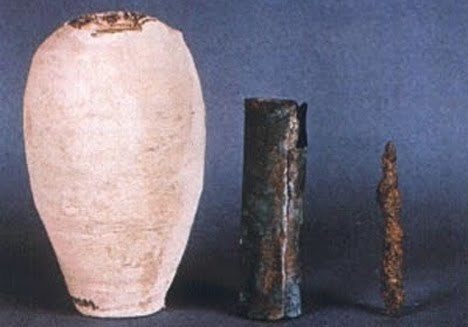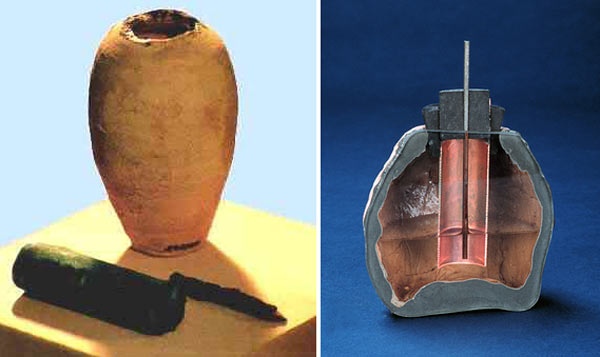- The hypothesis of the invention of the battery is very unlikely both scientifically and historically, even if we can always imagine that we add elements to an object to make an electric battery.
- The gilding of metallic objects by electrolysis would suppose that we had, in Antiquity, gold salts in solution, which is even less likely.
A MYSTERIOUS ARCHAEOLOGICAL OBJECT
In 1936, archaeological
excavations of a necropolis to the south-east of Baghdad brought to light,
among several hundred objects, glassware, earthen figures, engraved tablets,
etc. a curious collection that can be dated from the Parthian period, between
the first century before and the first century after Jesus-Christ. Inside a
terracotta vase about fifteen centimeters high, the neck of which, chipped,
bore traces of bitumen, were
- a copper tube whose bottom was covered with a thin
layer of asphalt
- the rest, very rusty, of an iron rod
This set, after passing
through various intermediaries, arrives at the Austrian archaeologist Wilhelm
Koenig, then director of the Baghdad museum. He emits the idea that once
brought together, these elements constitute an electric battery, of which he reconstructs
the diagram: to complete it, he wrote in 1938, it suffices to pour a saline or
acid solution into the copper tube.
Indeed, two metals of
different nature immersed in an electrolyte, such is the principle of the
battery, invented by Alessandro Volta in 1800.
Koenig supports his
hypothesis of an electric battery by the observation, without a priori
relation, of a rudimentary technique of electroplating, used in the 1930s by
the silversmiths of Baghdad to gild jewelry.
These silversmiths used
the device shown in the battery. This is a battery, short-circuited, inside
which the desired chemical reaction occurs. During this reaction, metallic gold
from the solution of a gold salt is deposited on the object to be gilded D. The
process could well, suggests Koenig, have a much older origin. But this device
has little to do with the mysterious vase. The only link, not explained by
Koenig, is that it would provide a second testimony to a mastery of electricity
by the Parthians.
The process also
supposes the use of gold salts in solution, which in Antiquity is extremely
hypothetical. Gold does not oxidize and is only found in nature in the metallic
("native") state in gold nuggets or, in traces, in a few rare ores.
Before medieval alchemy, we do not know of a method allowing to
"dissolve" gold - that is to say to make it pass to the state of
soluble "salt", by a chemical reaction.
Let's go back to the
mysterious object from 2000 years ago. Not long before, several similar objects
had been unearthed in another excavation in Mesopotamia. The copper cylinders
inside the pottery contained plant fibers suggesting to archaeologists the
remains of papyrus scrolls. But Koenig emits the idea that these pottery could
have been put in series, as batteries, in order to increase the electrical
voltage delivered. And he goes even further by highlighting the existence of
older bronze and copper vases which, according to him, could have been gilded
by electrolysis with these batteries in series.
It remains to be
specified which electrolytic gilding device would have been powered by such a
battery of batteries. All electrolytic devices for gilding, the first having
been developed around 1840, are based on the use - again very problematic in
Antiquity - of dissolved gold salts.
In 1939 Willy Ley, an
American engineer and popularizer of science popularized Koenig's idea in a
science fiction review. The second world war occurs and the "piles of
Baghdad" remain in the shade for some time.
THE DEVELOPMENT OF THE "ELECTRIC" INTERPRETATION
After the war, an
American researcher of the company General Electric, Willard Gray, tries the
first reconstitution of the "battery of Baghdad" according to the
indications of Willy Ley and obtains a weak electric current. Willy Ley said he
was convinced "that at the time of Christ, we had galvanic batteries in
Baghdad". Other experimenters engage in reconstitution and show the
possibility of obtaining a weak electric current with different solutions
(grape juice, lemon juice etc.).
In 1978, the
archaeological object was presented in an exhibition on Iraq at the Roemer and
Pelizaeus Museum in Hildesheim, Germany, and the catalog bluntly explains that
the Parthians invented the battery long before Volta. A television report
increases the credibility of the matter by showing a technician in a white
coat, in front of the device.
Arne Eggebrecht,
director of the Museum, manages, by assembling a battery of these reconstituted
"batteries", to cover a metallic object with an extremely thin layer
of gold. But the experiment has not been published, and one wonders what type
of electrolysis allowed the gilding.
This does not prevent
the "electric" interpretation from being very popular today, it is
only to surf the Internet to realize it. In 2005, MythBuster (literally
"myth breaker"), a Discovery Channel flagship show hosted by two
specialists in special effects, reproduced the experience of gilding in front
of viewers and deduced that the Baghdad stack hypothesis is "plausible".
By an adventurous
association of ideas, the connection is sometimes made with a bas-relief of the
temple of Denderah in Upper Egypt, on which some do not hesitate to see a
foreshadowing of electric bulbs or discharge tubes. After Volta, it's now Edison
who has to worry about! The battery and electric lighting would therefore only
have been "re-invented" in the 19th century after several centuries
of obscurity.
The affair brings into
play several springs of popular science, the mystery, the spectacular, the
discovery of hidden ancient knowledge, and a certain thirst for
"revenge" on official science.
YES, BUT HERE IT IS...
Several objections are
opposed to these interpretations. We have already mentioned some of them.
Koenig suggested that
the method of the silversmiths of Baghdad in the twentieth century was the
continuation of ancient skill. But Gerhard Eggert recalls in 1995 that this
method was described in the English patent for electroplating filed in 1839. No
prior art is known to this process.
Archaeologists have also
shown that ancient jewelry could be plated using very fine gold leaf, this
delicate technique being well mastered by goldsmiths in the Middle East 2000 years
ago. Mercury gilding using an amalgam (a liquid gold-mercury alloy) was also
known at the time.
As for the gilding
experiment which would have been carried out, but not published, by Arne
Eggebrecht, we do not know the details. We can only be surprised at the result
announced. Our experiments, in agreement with the theory of electrolysis, show
that one cannot obtain gilding by electrolysis without gold salt in solution.
Paul T. Keyser imagined
another electrical application for the mysterious vase, already mentioned by
Koenig: a medical use of the current produced, possibly in a religious context.
But the voltage delivered by a single "battery" is much lower than
the values to which the human organism is sensitive when applied to
the skin.
Finally, as science
historian Allan Mills points out, the object itself seems to agree with
difficulty with the hypothesis of an electric battery. There is in fact the
absence of metal wires essential to conduct the electric current. If this
absence can be explained by a disappearance linked to the age of the objects,
the presence of such wires does not seem to have been foreseen: the bitumen
plug, which permanently closes the vase, prevents the exit of a conductive
wire. from the copper tube and makes frequent replacement of the electrolyte
inconvenient, the composition of which would be rapidly degraded by the
chemical reactions linked to the production of a current.
Generally speaking, the
possibility of an experiment does not prove that one sought to achieve it by
constructing the object. This interpretation is ultimately based only on a
resemblance in form to a modern object (the Volta stack), and not on the
knowledge we have of the way of life of the owners of the object in antiquity.
In the 1930s,
archaeologists had already advanced, as we have seen, the hypothesis that the
vases discovered in Iraq would rather be receptacles intended for the transport
of small rolls of papyrus, perhaps formulas for prayer. Allan Mills proposed a
more prosaic hypothesis: the device could be intended to repair holes in skin
bags, very precious objects for life in the desert. The pointed iron rod,
heated over a fire, allows you to melt a little bitumen from the stopper and
apply it where the skin is pierced! A way to show that imagination can take the
most diverse directions. This interpretation, however absurd it may seem at
first glance, is however inspired by a concrete knowledge of the way of life of
nomadic populations in desert regions.
TO CONCLUDE
The presence in the
mysterious vase of two different metals remains unexplained. The point is that
by adding an electrolyte - and two metal wires - the device can produce a very
low current. However, it would be surprising if this technology remained so
confidential that it left no trace, led to no testimony from foreign travelers,
and finally that it disappeared for nearly two millennia. The battery
hypothesis, which poses, as we have seen, serious technical problems, even if
the experiment is possible, remains to this day historically, archaeologically,
and scientifically unlikely.






0 Comments